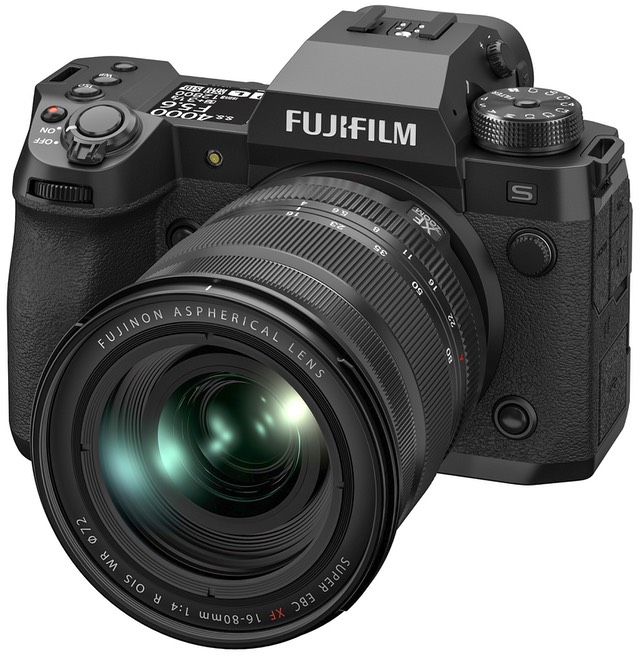
What is It?
It’s been a while since I’ve written a Fujifilm APS-C body review. I’m working my way past that brief lapse starting today with the X-H2S, ostensibly Fujifilm’s top APS-C model.
While it was a little unclear where the X-H1 fit into the Fujifilm XF lineup, the X-H2S and X-H2 now make it more clear: the H twins are Fujifilm's pairing at the top of their lineup, and both are designed as "hybrid" cameras (excellent at stills and video). The X-T line—starting with the latest X-T5—now becomes the top stills-oriented camera (though it still has video ability, it's not as extensive or fleshed out as on the H series).
The H series is now a Nikon-like twinning: same camera body, but two different sensor packages provide different experiences. The X-H2 is 40mp (a new top pixel count for APS-C) and oriented towards resolution over all else, while the X-H2S being reviewed here is 26mp with a stacked image sensor designed for speed. Both models have a new X-Processor 5 image processor to deal with all the data each is creating.
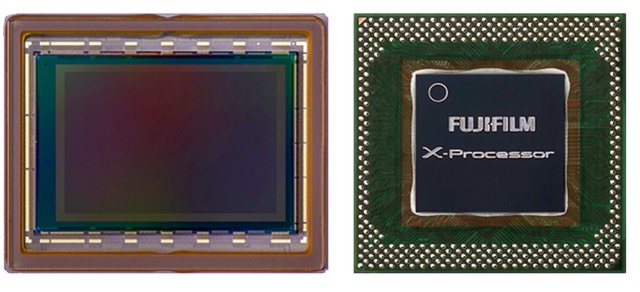
And on the X-H2S, that's up to 40 fps with 14-bit raw, 10-bit HEIF, or 8-bit JPEG. That's using an all-electronic shutter that's due to the fast stacked sensor mechanism (above left) coupled with a new X-Processor5 (above right).
With mechanical shutter, the X-H2S can still manage a very respectable 15 fps, which would put it in at the top of the current APS-C world on its own. Coupled with a very fast 35ms shutter lag, a pre-shot mode (images being buffered prior to pressing shutter release), and an electronic shutter that goes to 1/32,000, the X-H2S has a strong emphasis on "speed."
Fujifilm's rating is a worst case of 140 uncompressed raw files in the buffer with state-of-the-art CFExpress Type B cards. The camera has two card slots, one CFExpress Type B, one SD (UHS II capable). Note, however, that some video formats require the use of the CFexpress slot, and a fast one at that.
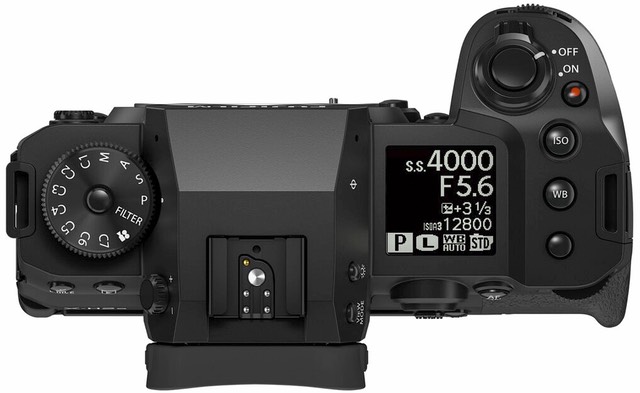
It's probably worth taking a tour of the body before getting into more details, as the X-H2 series features a lot of changes and enhancements to the traditional Fujifilm bodies. Most noticeable is that the X-H2 series features a Mode dial and no dedicated ISO, shutter speed, or exposure compensation dials. Besides the usual PASM settings, the X-2H series has seven Custom modes that can be programmed, plus Filter effects and Video positions. That latter bit, as I'll point out later in the handling section, is probably the one thing that Fujifilm did that somewhat cripples the video side of the camera. The camera should really have a stills/video switch, as the major three camera companies have all migrated to that construct for a reason.
The body is the usual internal metal frame, well weather-sealed, and rated down to -10°C. The focus thumb stick has been moved to a more thumb-friendly position near the top plate, and is both easier to find and more sure in its precision. The front and rear command dials no longer have an indent position to trigger a button-like effect, and are Nikon-level rigid, with clear click stops.
As befits a high-end camera, we've got a plethora of buttons, 14 of which can be programmed (with as many a 70 options, though not every function is available for every button, a problem that Fujifilm seems to have inherited from Nikon). Fujifilm's usual Q (quick menu) button is there, as well. There's also a PC sync socket for studio flash, another option that a few pro photographers may appreciate.
The viewfinder on the X-H2S is a 5.76m dot OLED one, with a 24mm eye point and .8x magnification. Normally, it functions at 120 fps. Frankly, at high speed and in low light, the viewfinder is grainier than I'm used to with lower resolution Nikon EVFs. You can use a boost mode to give priority to resolution or lower the frame rate to improve the low light capability, but this is not an automated function. There's also a 240 fps mode that tends to lower viewfinder brightness and seems to use interlacing, so isn't as smooth as I'd like. While I can see the whole image area with my glasses on, I get a little cutoff of the information areas at top/bottom that I have to move my eye to see.
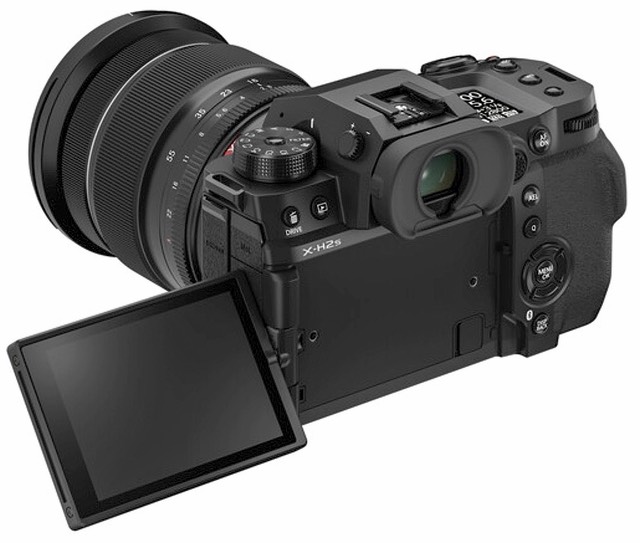
The Rear LCD is a fully articulating 3" TFT with 1.62m dots, and is touch sensitive (but not for menus; only quick menus). For stills use, you have to flip the LCD away from the body to get “tilt” (above photo). On the other hand, you can flip the LCD so that the display is not exposed during travel, a preference I have due to the nature of the travel I do (it's tough on big displays, which can get scratched easily).

The connections on the X-H2S are as you'd want them to be: microphone in and headphone out (3.5mm jacks under separate doors), USB-C 3.2 with USB Power Delivery capabilities under another door, and a full size Type A HDMI socket under a flap (not a door). Why the HDMI connector gets the less reliable and annoying flap and not a door I don't know. I found a couple of times that the flap had come slightly undone, compromising the weather sealing, but never had that happen with the doors. You also get basic Wi-Fi and Bluetooth capabilities, and even the ability to talk to Instax printers.
Up front you’ll find a substantive hand grip, with a sculpted cutout that helps keep even fat fingers from running into the lens.
Three additional components can be mounted on the X-H2S body: a fan (FAN-001, US$199) can be mounted on the back of the camera with the Rear LCD flipped out (to help cool the camera in extended video work); a file transmitter grip (FT-XH, US$999) adds vertical grip and controls plus faster Wi-Fi, FTP, and wired LAN options; and a basic full vertical grip (VG-XH, US$399) can be mounted to the bottom of the camera (see door at left on bottom of camera, below).
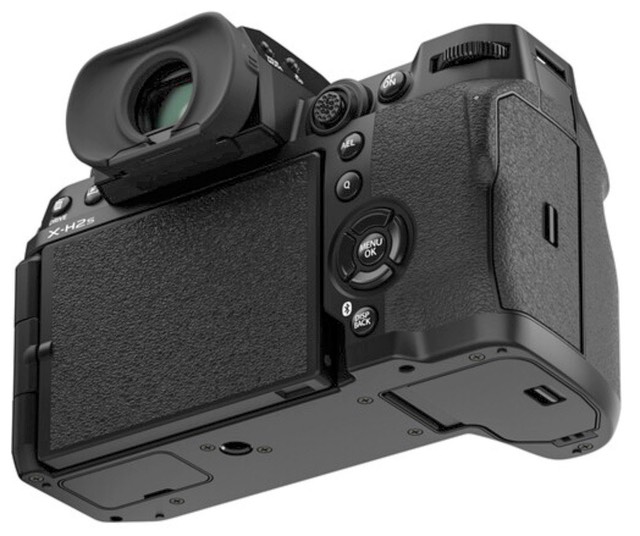
The fan screws into the back of the camera, so isn't quickly added/removed. The grip mounts into a hidden compartment of connectors with what I feel is a slightly too insecure door. I had mine dislodge once. Had I not noticed that and picked up the small plastic door from the ground, the camera would have been vulnerable to water ingress. I’d consider taping over the door if not using grips (some Arca plates also cover this area).
The X-H2S uses the NP-W235 battery that Fujifilm has been using in the top cameras in their lineup, and that's rated for 580 shots CIPA when the camera is set normally, 720 if set to some power conserving modes.
Overall, the body is a bit big for an APS-C camera—as big as my Nikon Z full frame bodies other than the Z9—and weighs in at 23.3 ounces (660g) with battery and card installed.
Let's move inside the camera and talk about some of its other abilities. The image sensor is mounted on a stabilization platform, and provides five-axis control of motion. Fujifilm claims up to 7 stops performance (sensor+lens), but remember that the CIPA testing has a very specific motion that it's testing for, and the camera companies are now starting to game that to get expanded marketing claims.
The focus system is a hybrid system that performs phase detect on the image sensor in up to 425 areas. 13x9 and 25x17 grids of selectable areas are available, as are smaller zones. Fujifilm makes a big deal about their subject detection capability; the X-H2S can recognize people, animals, birds, bikes, cars, planes, and trains. Unfortunately, not at the same time. You have to tell the camera what to detect. You'll end up programming buttons to turn subject detection on and off, and to select what to detect. This is a bit cumbersome and can cause you to miss images if you're constantly moving between types of subjects.
Like Nikon's Z9, the X-H2S can recognize the body, head, and eyes of an animal or bird, though the X-H2S seems to be less reliable in doing so, particularly at distance. Likewise, the X-H2S can do that for humans, but again, that requires you to get out of the other subject detection modes. Curiously, you can select Eye Off, Eye Auto, Right Eye Priority, or Left Eye Priority for people. Auto is really Auto, and doesn't allow you to override to the other eye as do some other camera company's implementations.
The X-H2S's other claim to fame is a substantive video capability, including 6.2K open gate and 4K/120P. The latter happens with a 1.29x crop. FullHD can even hit 240P (with a 1.38x crop and a quality drop). 10-bit 4:2:2 is supported internally, including use of the Apple ProRes compression schemes (from LT to HQ). 12-bit ProRes RAW or Blackmagic RAW video is supported via the HDMI port and compatible recorder. HLG, F-Log, and F-Log2 are supported as profiles, while many like the Eterna film simulation mode for graded video out of the camera. While the X-H2S has that optional fan, I didn't have overheating shutdowns under normal conditions using up to 4K/60P, though the high temperature warning did come on after an hour.
The X-H2S retails for US$2499 for the body only, and is the only body I've received that doesn't have a label with the serial number and place of manufacturer on it. The serial number is in the card slot.
Fujifilm's Web page for the X-H2S
Source of the reviewed sample: long-term review on loan from B&H, using firmware 2.10
How's it Handle?
The Mode dial but no dedicated dials design of the X-H2S seems to cause consternation among many of the Fujifilm faithful. It does not for me. Dedicated shutter speed and ISO dials were what we used in the 1970's, before the camera companies learned that many of us preferred to keep our eyes at the viewfinder and have a way of changing settings without moving our head or hands.
So let me begin with a strong statement: if you're buying the X-H2S for its speed, stop lamenting the design. Fujifilm made the right choice (basically emulating the long-held Nikon front/rear command dial interface). It's in the details that I find a lot to be desired.
For instance, let's start with the Mode dial itself. Easily changed with the left hand while the camera is being used at the eye. Fujifilm has even given you seven custom settings modes via the Mode dial (most cameras give you two or three). The mode display in the viewfinder is small, and at the bottom left of the display. It's easy to miss that you're changing the mode (though there is a settable lock on the dial if you find this to be an issue).
Which brings me to that lock button on the dial. I keep seeing people say they don't want a locked Mode dial. They insist that the lock button be removed. But you don't have to use it ;~). This "remove something I don't use even if someone else does use it" nonsense has to stop. You can have it your way. Just don't press the button! Yes, I know it can get engaged accidentally with rough handling of the camera, but your preferred choice is still just a quick press away.
I prefer a lock button on the Mode dial, particularly when I'm in Manual exposure mode (I don't want to accidentally be moved to another mode, and I often lock the manual exposure itself, too).
If there's an issue with the Mode dial it's that Fujifilm puts the Video setting there. Fujifilm claims that the X-H2s is their top end hybrid stills/video camera, but this is one example of where they haven't fully thought through what that really means. Canon, Nikon, and even Sony have gone to a stills/video lever so that their cameras' full complement of controls are available to both types of work. Shooting Mode on the X-H2S (exposure mode in Nikon parlance) is set via the menu for video, via the Mode dial for stills. Oops.
Moving to the buttons, another mixed bag. There's a good number of them, most customizable, plus the four clickable direction pad edges, as well, are customizable. My biggest complaint is that most are small buttons, barely sticking out of the camera body, and not particularly well suited to working with even thin gloves. Worse still, I find that I have to strongly press some of these buttons to engage them. The WB button on the top panel, for instance, didn't always engage on my sample with a casual press, I had to be emphatic. The buttons also don't override one another. If you're setting WB, pressing the ISO button doesn't make the camera switch to that (and vice versa). Curiously, the unmarked button behind the WB button will override setting white balance ;~).
The Top LCD display is, unlike many cameras, very easy to read, with large type used. The backlight button is conveniently located on the side of the prism near the display, and that makes the Top LCD easily read in low light. Bravo. Canon and Nikon to fix their top LCDs now ;~). Meanwhile, the fully pivoting Rear LCD will be appreciated by the video users of the camera, not as much by the still users (who have to rotate it out to tilt it up).
However, the biggest handling failure of the X-H2S continues to be Fujifilm's inability to wake a camera on button press. Camera went inactive? Press the MENU button. Nothing. Press the AF-On button. Nothing. You must half press the shutter release to reactivate the camera, and frankly, on my sample that requires essentially a full press, which feels wrong (no picture is taken). A speed camera should emphasize speed. If my camera has gone inactive and I want to set something in the menus, I shouldn't have to press the shutter release to reactivate the camera first, I should be able to press the MENU button and get there directly.
My general problem with the handling of the X-H2S is that it simply doesn't feel refined. The engineers defining how the controls all work have never been photographing at 10+ frames a second and needing to change something rapidly before the action ceases. It feels like there's always "an extra step" involved. Even the Q (quick) menu system is a bit awkward and extra-steppy. The basic operation is that you engage it via the Q button, move your finger down to the Direction pad to control which item you want to change, then move your finger up to the command dial to make the change. My suggestion: use the LCD touch options with the Q button, it's faster and you can see what your options are rather than having to discover them via command dial turn.
Back when the first Fujifilm X cameras appeared, I thought Fujifilm's menus were pretty logical and well organized. No longer. We now have four pages of Image Quality settings that are not well organized and which refuse to use hierarchy when they should. The good news is that JPEG users are mostly just going to set a Film Simulation, which is the fifth item on the first page. We get one page of video settings, unless the Mode dial is set to Video, in which case we get eight more! So, to set one of the Custom Setting numbers on the Mode dial to a video use, you first have to move the Mode dial to Video, then before you leave, you need to go to the next-to-the-last item on the three-page menu and save it via Custom Mode Setting. It's up to you to remember which numbers you assigned to video settings, and which to stills. There's also a long lag when you move the Mode dial from video to a stills setting before the menus rejigger themselves.
The Fujifilm menus are also the only ones I've ever seen with an Information/Error Description option. Instead of explaining the error directly, you have to navigate to a menu item to see what actually happened. If no error has occurred, the page is blank ;~).
I suggest that the Fujifilm team needs to study my friend Alan Cooper's seminal book on user interfaces [Amazon link; as an Amazon affiliate I earn from qualifying purchases]: direct and simple, not indirect and complex. This isn't to say the X-H2S is terrible to use. It just takes learning and tolerance of extra steps. There's a bit too much "I have to adjust to the camera" rather than "I can make the camera adjust to me." The X-H2S also doesn't have the clickable command dials of some former Fujifilm cameras, which I'm sure some will miss.
That said, the X-H2S has an excellent hand position, strong grip, and most buttons (without gloves) are easily identified by touch without looking. The right thumb has a substantive raised area that makes it easier to one-hand the camera while photographing. The camera isn't light, and feels substantial in hand, which is what I prefer for a camera on which I'm likely to be putting longer, heavier lenses.
The camera strap points are also well aligned for balance, something that seems to escape some camera designers. I also like the hinged doors on the camera protecting connectors, though they all have finger openings from different sides, which takes some getting used to. For some reason, the full-sized HDMI connector doesn't have a hinged door, though.
For some of my review time, I was using the X-H2S in a fairly abusive ocean edge environment. The camera sloughed off the abuse well, and I had no issues with the weather sealing (which was needed).
How’s it Perform?
Battery life: It’s the usual result in terms of battery life with mirrorless cameras. Battery life is more a statement of hours of operation than it is the number of photos you can take. Fujifilm claims 580 images CIPA in normal mode, 720 without power saving. In the month I was intensely using the camera I was averaging higher than those numbers, but partly because I was doing a large number of continuous sequences as I tried to work through the autofocus system nuances. I never wore out a fully charged battery on one shore excursion in the Galapagos, for instance, which was averaging about four hours in length—on my workshops we’re on the island at 6am, and typically off about 10am, unlike what the other ships are doing—and hundreds of images taken.
In the less intense times I’ve been using the camera as more of a walk-about camera, the number of images I get is less than the CIPA statement, but still acceptable.
I’m comfortable saying that two batteries a day would probably serve even the most productive photographer. That said, remember, it’s more about “time on” than “photos taken.” Even someone walking around all day taking only an image a hour, but composing and checking possible images during that hour, is going to go through a couple of batteries a day, even though they might have taken only 12 images. The X-H2S, though, is far better with batteries than my Nikon Z50, or even the Canon R7 I tested recently.
Buffer: While Fujifilm claims that there are performance differences between some CFExpress Type B cards in the camera, I didn't really find that in any of the cards I was using (Delkin, ProGrade, Lexar) with compressed raw. I did find heat variations (the Lexar card heated up fast). Moreover, I found that the camera sometimes exceeded Fujifilm's claims. I did find some modest variation in buffer using uncompressed raw, though (slower cards produced lower results).
At 40 fps I was getting as many as 160 frames of compressed raw, or about four seconds of continuous images. At 30 fps that increased to over 200 frames, and at 15/20 fps, the buffer was near inexhaustible. With JPEG, you get that near infinite buffer at 30 fps (though curiously, no real improvement over raw at 40 fps). Lossless compressed raw was very close to compressed raw performance, with the primary difference being that once the buffer filled the on-going frame rate dropped some. In all cases, the X-H2S continues to photograph at a reasonably high frame rate after the buffer fills. How high depends a bit on what file format you're using and the speed of the card. At times I was getting 15 fps with the buffer full, though this dropped to as low as 5 fps in some cases.
I did not test performance with SD cards. Just from expected maximum card speeds alone, even for UHS II, you should see a substantive drop in full buffer performance to the point that if such performance is important, you're going to only use the CFExpress slot.
The pre-shot capture mode basically steals one second of the buffer. So at 40 fps, you get one second prior to pressing the shutter release and three seconds before the buffer fills at worst case file setting.
Autofocus:
Note: as I was returning the camera to B&H, Fujifilm released firmware 3.0, which features major improvements to the subject detection and tracking. I’ve confirmed that these things do indeed improve the focus system, but I had very little time with them and can’t speak to how much they improve the system. I still saw a few tracking errors, though not nearly as bad as during the review period with the 2.x firmware.
Fujifilm’s scattered settings leave a lot to be desired. You have to pick a subject to detect to get best results, and at times the algorithms get in the way. For instance, with birds the eye detect works great for static birds, and even on BIF on plain sky. But when the bird dips down so that there’s a busy background, the eye detect starts failing and seeing the wrong thing. You’re not going to have time to drop into the Q (quick) menu to turn off eye detect during a sequence, so what do you do?
Well, you dip into the other customization capabilities of the camera. One problem with this is that Fujifilm’s own settings advice often doesn’t work as well as other choices ;~).
Like many others have discovered, I eventually set a 3x3 zone and steered it when necessary (some suggest 7x7 instead). The camera can recognize heads/eyes outside of the zone, but at least part of the zone needs to be on the subject. But that by itself doesn’t answer all the issues. Dialing in the right Tracking Sensitivities helps. Still, even with a full set of customizations that helped me dial in “better” continuous results, I found unpredictable times when the subject detection just got lost and I got a focus hunt sequence. The solution? Program a button to toggle subject detection on and off.
If you're getting the notion that this autofocus system needs a lot of manual control, you're correct. More so than I'm used to on the Nikon Z9 or Sony A1, where I advocate for taking control of the focus system at times.
Even adding all the full set of controls and overrides I could come up with, I still noticed times when the camera simply missed putting the focus where I wanted it. I was using the X-H2S side-by-side with a Z9, and the differences were obvious: the Z9, once locked in on a subject, stayed locked; the X-H2S mostly stayed locked onto the subject, but strayed at times I couldn’t predict and then had to react to. The Z9 also had the advantage of being able to distinguish between birds and other animals, while the X-H2S really needs to be set to a specific type of subject to do its best job (people, birds, animals, cars, etc.).
I note that this problem happened more with the mechanical shutter at 15 fps than with the electronic shutter at 30 fps, so it’s clear that the blackout caused by the mechanical shutter was impacting results. Still, it happened at times with the electronic shutter. I was trying to avoid the electronic shutter with some of the birds because of rolling shutter impacts.
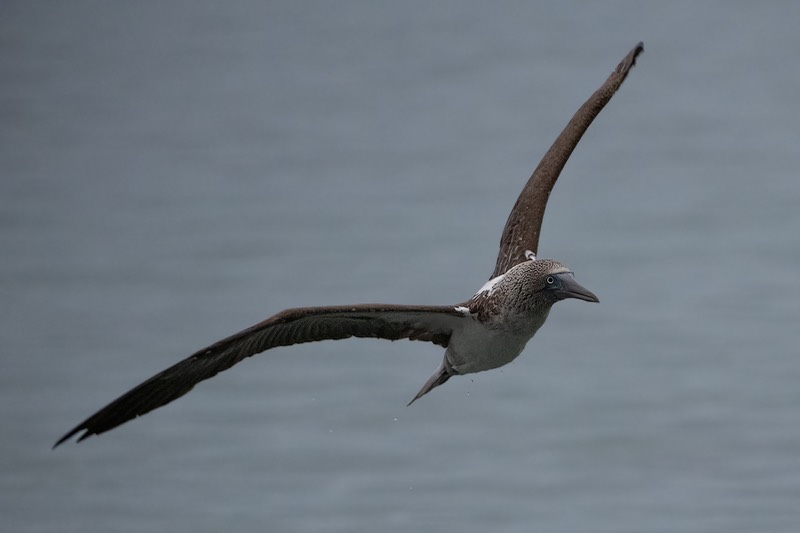
Here are two images in a 15 fps sequence (these are both cropped, and I didn’t perfectly match the crop). In the above image we have focus on the eye, as expected. But the focus looks like the image below for the next image in the sequence: focus lost).
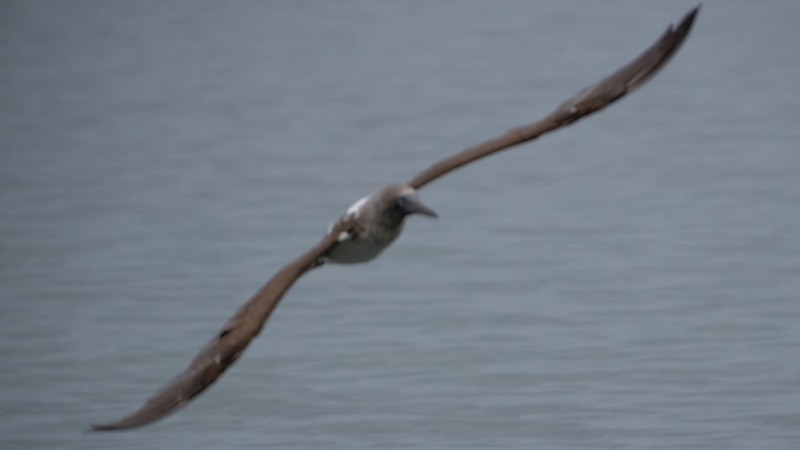
The image following this one was nearly back in focus, the one after that and the rest of the sequence is fine.
That said, the focus performance is generally fast and accurate. Better than the Canon R7, in my experience, but clearly worse than the Nikon Z9 and Sony A1. In "flocks of BIF" situations, the X-H2S locked onto one bird and followed it, whereas I found the Canon sometimes would switch very randomly (The Nikon and Sony switch sometimes, but this is usually predictable and what you want to happen). The Fujifilm X-H2S also stayed locked onto BIF after they'd passed me and the camera was no longer seeing the eye, which I guess is a good thing, though rarely produces a usable image. Photographing from a moving Zodiac also didn't seem to phase the X-H2S; it could deal with me bouncing and rocking and still manage to hold focus.
Backgrounds sometimes confused the camera, too.

Images previous to this where the bird was on a plain background were fine, but as I panned past the bright ship in the background, the X-H2S didn’t quite know what to do. It kind of kept the focus forward towards the bird, but it didn’t stay dead on the bird. The Z9 in the same situation didn’t flinch and stayed on the bird’s eye.
I also had the chance to use the Fringer Nikon-F to Fujifilm XF adapter. Nikon makes some lenses that have become seminal for wildlife photographers, particularly the small and light 300mm f/4E PF and 500mm f/5.6E PF. These worked acceptably well on the X-H2S, far better than I expected, and virtually like a native lens. Focus speed or accuracy didn't seem to be impacted, though I did sometimes see the PF lenses hunt a bit more than a native XF mount lens, and there were a couple of sequences where it took the X-H2S longer to lock into initial focus.
Overall, the X-H2S feels just a little behind the current state-of-the-art in autofocus, which is a shame, as otherwise I'd have no real issues with the camera. Too often in my continuous sequences I see short focus lapses, and too often in trying to acquire initial focus I found small hiccups before focus was clearly obtained. Again, this happens more often with the mechanical shutter than the electronic one. I also don't like the fact that animal and bird detection are separate modes. On most wildlife trips, this forces me to tell the camera what to do when I really want to just respond to any new subject in front of me, whether mammal or bird.
If you look carefully enough on the Internet, you'll find that my specific complaints about the X-H2S autofocus system are echoed by a number of others who do the same types of photography as I do.
Disclaimer: due to the limited period during which I had to review the camera I wasn't able to test it on many sports. Thus I can't speak to what the camera does with really complex focus issues in some sports (helmets, face guards, overlapping player movements, etc.). Based upon what I was able to test, I'd guess that clear face views with more limited player overlap works fine for focus (track and field, basketball, soccer). I'm not as sure about sports like ice hockey, lacrosse, and others, however.
Image quality: Before I drop into details, I should mention that the X-H2S has a very flexible file format capability. Besides 8-bit JPEG, you also have the choice of 10-bit HEIF, 16-bit TIFF, and three different raw formats (uncompressed, lossless compressed, and compressed). An uncompressed raw takes about 55MB an image, while lossless compressed more than halves that (23MB).
For the in-camera formats, you also have Fujifilm's "film simulations." While I disagree with Fujifilm that these look like the film they're named after, they do provide a somewhat more useful set of choices than the other camera companies provide.
One thing I was particularly interested in looking at was the rolling shutter effect at 40 fps electronic shutter. The best-in-class stacked sensor at the moment is the Nikon Z9, which provides slightly better than 1/250 second offload, or basically equivalent to a mechanical shutter. The Sony A1 is right behind the Nikon. The X-H2S isn't in the same class, unfortunately. I judge the rolling shutter on the X-H2S to be somewhere around 1/125 second. I can clearly see vertical tilting and wing flap annoyances on the X-H2S that I don't see on the Nikon Z9 and Sony A1. It's not highly objectionable, but it's there. If you're doing quick pans with subjects, you might want to stay with the 15 fps mechanical shutter, but note my comments about focus performance, above.
Compared to the X-T4 I last tested, the X-H2S comes in lower in dynamic range by almost a half stop when below the gain change (above ISO 400), but only about a sixth of a stop less when above the gain change. Initial examination of an X-H2 tells me that it is nearly identical to the X-T4, with the only difference being the base ISO value. Maximum useful dynamic range at base ISO on the X-H2S works out to almost exactly 10 stops.
The X-Trans image sensor has long been a difficult one to pin down when it comes to anything associated with image quality. The increase in green detection and decrease in red/blue compared to the more traditional Bayer sensor gets a bit in the way of any apples-to-apples evaluation, and particularly so because the demosaic for X-Trans does different things when evaluating neighboring photosites to interpret color information.
X-Trans demosaics have gotten "better" since this form of image sensor originally appeared, which also slightly confuses the comparison, as Bayer demosaics have long been highly optimized. The low-level color artifacts I reported early in the X-Trans history are mostly gone, at least in what would be visible pixel-level problems, even with the Adobe converters. I'd still characterize the Adobe X-Trans conversion as the "worst" of the bunch, but so much closer to the optimal conversion now that I mostly run my X-Trans raw images through ACR.
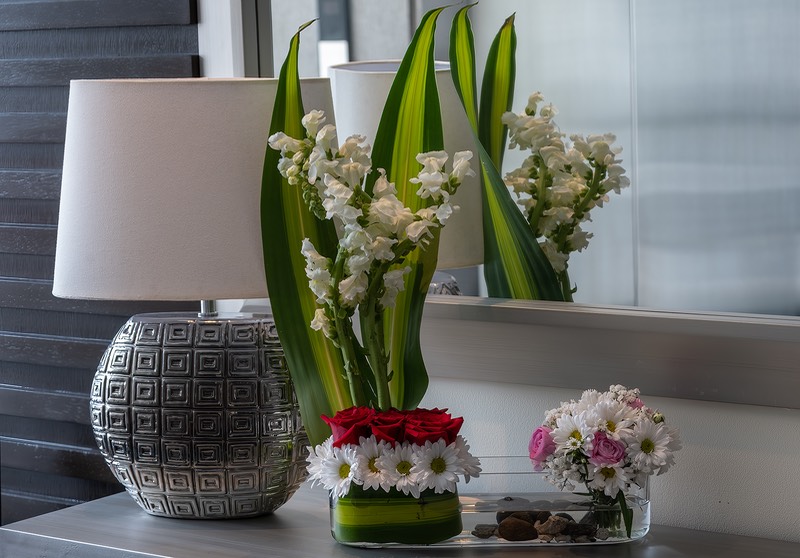
Most of the time I’m very pleased with the colors coming off the X-H2S. Greens, in particular, tend to have lots of subtlety to them, and the reds don’t seem to be compromised. Blues still have a slight tendency towards cyan in camera, though not in raw converters. Highlight retention and detail is quite good.
I'm going to write something that appears controversial at first, but really isn't. In looking at Nikon Z50 and Fujifilm X-H2S images I was taking side by side, I'm not seeing anything fundamentally different in terms of what I can achieve. The Z50 nets about a half stop better dynamic range at its lower base ISO, but the dynamic range profile of the two cameras seems about the same other than some digital number mischief that both makers do at above ISO 12800.
The reason why this isn't controversial (;~) is that both cameras use Sony Exmor sensor technology at their base, and for any given sensor size—in this case APS-C—the results are going to be nearly identical in terms of photosite production. The X-H2S gets a small detraction from its use of a faster stacked sensor offload, the Z50 gets a small detraction from using the previously best Exmor technology (now almost seven years old). The net is a wash in terms of dynamic range potentials.
So let me say this: I'm perfectly happy with non-cropped images from either a Fujifilm X-H2S or a Nikon Z50. Neither is as good as my full frame cameras, but that's to be expected simply from capturing more light over a larger area.
That said, I do have to write about a few things I do see in the X-H2S raw images. As you might expect, the X-Trans' strength comes in greens. While you might expect that—more green photosites—it isn't a given. The actual placement of any "green” also depends upon the red and blue channels, too. I'm pretty sure that Fujifilm is using a somewhat different red and blue filtration than does Nikon or Sony on the similar sensors. This is allowing the raw converter color models to pull out a bit more subtlety in green rendering, though the default seems to be towards moving greens towards the yellow part of the hue circle. Indeed, I have to move Calibration/Green Primary/Hue upwards in ACR to match the same scene on an X-H2S to my Z50. Meanwhile, I’d judge the Fujifilm reds now to be slightly better than Nikon’s (which are better than Sony’s), but the Nikon’s blues being better than Fujifilm’s. It’s subtle, and this really mostly impacts in-camera JPEG creation, but it’s there.
Which brings me to another point about raw files. Adobe's Detail settings in ACR are just way wrong for X-H2S X-Trans. They produce more noise than necessary, and don't really optimize detail correctly, either. I was actually questioning how well a lens was working before I decided to try to figure out where the problem was actually occurring. If you're going to use Adobe as your converter, I think you'll need to go through the full set of base settings and adjust them properly to get best results, then save that as a Preset. Best results are quite good. As good as any other 20-33mp APS-C sensor is producing.
In terms of raw converters, I got somewhat better results from Capture One than DXO Photolab, and somewhat better results from DXO Photolab than Adobe ACR. Capture One tended to produce the most detail but needed to be adjusted for sharpening/noise to do so; DXO Photolab tended to produce the most accurate color though DEEP Prime tends to remove some detail; and Adobe was well, the Chevrolet of the bunch, being adequate but not best at anything (oh dear, I've just made a bunch of Chevy owners mad, but in my defense I'm thinking more Chevy Malibu than Corvette).
Final Words
What many people have been looking for is the mirrorless equivalent of the seminal Nikon D500 DSLR. They want a camera that’s pro-level and loaded with features and performance, but where the manufacturer has managed to do so at a cost well under the top full frame cameras (Canon 1Dx and R3, Nikon D6 and Z9, Sony A1).
To a large degree, Fujifilm has managed to do what people want. I can’t think of a better mirrorless camera that lives in the D500 space. My only problem is this: the D500 is still a better balanced and better designed camera with near bulletproof capabilities that doesn’t take a deep dive to master. I’m sure I’ll get a lot of flack for that statement, so I’m going to need to use more words to explain what I mean, many more words.
There’s nothing particularly wrong with the tech in the X-H2S. The parts are clearly state of the art. Stacked BSI image sensor, 26mp APS-C X-Trans pattern, new higher-speed image processor, well-designed mechanical shutter, sensor-based stabilization, and so on. Hot. All red hot on the YouTube viral meter.
It’s in controlling the tech that I start to have some qualms. Not big qualms, but in two weeks in the wilds of the Galapagos, I kept finding little frustrations in getting myself in full control of the camera, rather than vice versa. I’ve never felt that way about the D500. The X-H2S autofocus system, in particular, needs more fleshing out so that you're not always turning modes on and off to help it, and the menu system is a mess if you need to drop down into it to change something.
Fujifilm seems to have copied a lot of things from Nikon in this latest design, but it seems that they don't always understand what Nikon did to make those things direct and accessible in a user-friendly fashion. I'd guess that someone at the top at Fujifilm gave engineers marching orders to "do what Nikon did" but without understanding why or checking to see what the engineers came up with. For a camera where I need to change menu items or use a button to turn things on and off a lot not to wake on any button press is annoying, to say the least.
Basically, the X-H2S requires more study, more customization, more care by the user if you really want to maximize the results it produces. Day one was very frustrating for me. Day thirty I felt like I had mostly wrestled the camera and its settings to a level I was very happy with. That still didn’t feel “optimal” to me, as you end up programming things like the Direction pad sides to do useful things, but that also means you have to be careful not to accidentally brush the wrong side of the Direction pad.
As far as a "mirrorless D500," I find the X-H2S cigar-less (as in “close, but no cigar”). For many of you, that will be more than good enough. For me, it just made me appreciate the no-longer-sold D500 even more. Were Nikon still selling it, the D500 would still be the camera at the top of the APS-C game, in my opinion. Well, it would if it had enough other-than-telephoto lenses available for it that are appropriate. Towards the end of its life, the D500 became mostly a wildlife and sports camera due to the excellent telephoto choices that were available, but not so much a more generalized camera.
The X-H2S does get the "more generalized camera" part more right than Nikon, partly because of Fujifilm's extensive lens selection. What it doesn't fully get right is the "more specialized camera" part. I get the feeling that Fujifilm is still learning as they go, and that they haven't truly recognized what made some great DSLR cameras great in both the Canon and Nikon lineup.
I note that the X-H2S has been "in stock" and readily available pretty much since it first appeared. That seems to indicate that Fujifilm expected to sell more of them than they have. The US$2500 price is a bit of the problem, as that's way beyond any other currently available APS-C camera and starts to put the X-H2S in competition with a number of full frame cameras. The high-tech-spec-but-not-quite-nailed-usability might be another part of it, as reviews haven't been trumpeting Buy This Now! Ironically, the third leg of the lower-than-expected sales is, believe it or not, a bit of telephoto buzz-buzz (that's my shorthand for acting like an annoying fly when constantly mentioning a company's lack of lens effort).
For a speed camera, we have basically five truly useful telephoto options from Fujifilm: 50-140mm f/2.8 OIS, 70-300mm f/4-5.6 OIS, 100-400mm f/4.5-5.6 OIS, 150-600mm f/5.6-8 OIS, 200mm f/2 OIS. The 50-140mm is a necessary given, and most certainly pro quality. The three other zooms seem a bit more consumer than pro. And the fast 200mm is another Fat Boy (great, but hard to get your hands around ;~). Meanwhile, the Nikon 300mm f/4E PF on a Fringer adapter was exactly what the X-H2S really needs more of, only it's not a Fujifilm lens and the adapter can add some performance issues from time to time. No way is Fujifilm going to say to people "buy those other company's options."
Thus, I find myself lukewarm in my response to the X-H2S. There's a lot to like, and the tech side of the camera is capable and mostly what I'd want: the camera thus starts out as "hot" on the desirability meter. The usability bits get in the way at times, and tempers down the heat some, but still somewhat hot. The telephoto lens selection also makes me a bit less excited and losing some more heat in my enthusiasm. And so in the end, when I add everything up, I'm at lukewarm. Would I trade a Nikon D500 and its telephoto lenses for the Fujifilm X-H2S and its telephoto lens set? No. If I were looking for a D500-like camera on the market today would I consider the X-H2S? Yes. See my dilemma?
I can recommend the camera if you're willing to really come to grips with its usability through customization and study, and if the lens set works for you. But that's a lukewarm recommendation when I thought I’d end up with a slam dunk review and outright recommendation when I first saw the press release on the camera.
The good news is that Fujifilm does seem to listen to users and tends to move towards useful changes and fixes when they do. I hope they're hearing the X-H2S users clearly. I'm not the only one that's brought up a range of things that detract some from what should be a remarkable camera. Moreover, if you're in the market for this level of camera in an APS-C image size, there's also nothing else that comes close left on the market today. Yes, the X-H2S is a far better camera than the Canon R7, though you'll pay an extra US$1000 for that and tear out a different portion of your hair in trying to come to grips with it. Yes, the X-H2S can be fairly competitive with the full-frame speed cameras (R3, Z9, A1 these days), and it won't cost you nearly as much, but the X-H2S is also not yet in the same league, both usability wise and lens wise.
And, of course, Fujifilm decided to compete with themselves, offering both an X-H2 and X-T5 that use much of the same new technology (though not the speed stacked image sensor), but at lower cost.
In the end I find myself dreaming about what the X-H2S could have been, not what it is.
Recommended (2020 to present, lukewarm)